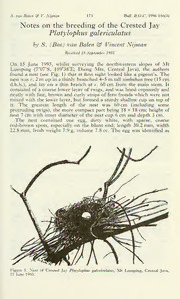
Notes on the breeding of the Crested Jay Platylophus galericulatus PDF
Preview Notes on the breeding of the Crested Jay Platylophus galericulatus
& 5. van Balen V. Nijman 173 Bull. B.O.C. 1996 116(3) Notes on the breeding of the Crested Jay Platylophus galericulatus & by S. (Bas) van Balen Vincent Nijman Received 18 September 1995 On 15 June 1995, whilst surveying the northwestern slopes of Mt Lumping (7°07'S, 109°38'E; Dieng Mts, Central Java), the authors found a nest (see Fig. 1) that at first sight looked like a pigeon's. The nest was c. 2 m up in a thinly branched 4—5 m tall simbukan tree (15 cm d.b.h.), and lay on a thin branch at c. 60 cm from the main stem. It consisted of a coarse lower layer of twigs, and was lined copiously and neatly with fine, brown and curly strips of fern fronds which were not mixed with the lower layer, but formed a sturdy shallow cup on top of it. The greatest length of the nest was 60 cm (including some protruding twigs), the more compact part being 18x18 cm; height of nest 7 cm with inner diameter of the nest cup 6 cm and depth 3 cm. The nest contained one egg, dirty white, with sparse, coarse red-brown spots, especially on the blunt end; length 30.2 mm, width 22.8 mm, fresh weight 7.9 g, volume 7.8 cc. The egg was identified as Figure 1. Nest of Crested Jay Platylophus galericulatus, Mt Lumping, Central Java, 15 June 1995. & S. vanBalen V. Nijman 174 Bull. B.O.C. 1996 116(3) that of the Crested Jay Platylophas galericulatus (using Hoogerwerf 1949 as a reference) and has been deposited with the Zoological Museum of Bogor (MZB Nr 1047). The nest tree stood on a rather steep (40-45°) west slope, at an m altitude of 950 m, c. 100 from a small river. In the surrounding habitat were many large trees, with a rather sparse middle storey. Crested Jays were rather common in the area and distant calls of this species were heard when the nest was discovered. The Crested Jay is a widespread inhabitant ofprimary lowland forest throughout Java, and is mainly found in pairs at 0-600 m, occasionally up to 1000 m (Bartels 1936; SvB pers. obs.). Madge & Burn (1994) reported that the nest is said to be jay-like but that otherwise the breeding of the Crested Jay is essentially unknown. The latter may be true for the other parts of its range (Thailand, Peninsular Malaysia, Sumatra and Borneo), but there is some literature available on its nesting in West Java, of which a brief summary follows. The first single egg reported in literature was found in October 1928 by van Steenis on Gunung Paniisan (Mt Salak, West Java) at 500 m asl (Hidma & Hoogerwerf 1935). The nest was sited on the main nerve of a robust fern frond; egg light blue-green with rufous brown spots, becoming dense near the blunt end and thus forming a broad circle. Hoogerwerf (1949) and Hellebrekers & Hoogerwerf (1967) describe in great detail this single egg; they also report two clutches ofone and two eggs, collected respectively in January and December by Bartels on Mt Masigit (West Java). MacKinnon (1988) reported breeding in October, with two white eggs, blotched with purple and brown, laid in a solid twig nest. Acknowledgements The authors are grateful to Messrs Cahyono and Madi, fortheirassistance and guidance in the field, and to Mr Darjono (Museum Zoologi Bogor) for helping with the measurements ofthe egg. References: Bartels, M. 1936. Platylophusgalericulatus De Trop. Natuur 25: 20. Hellekbnroewkelresd,geW.ofPthh.eJi.sl&anHdooofgeJrawvear(fI,ndAo.n.e1s9i6a7)..AZoofluorgtihsecrhecoVnterrihbauntdieolnintgoenou8r8:oo1l—o1g6i4c.al Hoogerwerf, A. 1949. Bijdrage tot de oologie van Java. Limosa 22: 1—277. Hidma, Th. & Hoogerwerf,A. 1935. Eenroofridderenzijngewoonten. De Trop.Natuur 24: 194. MacKinnon, J. 1988. Fieldguide to the birds ofJava andBali. Gadjah Mada University Press, Yogyakarta. Madge, S. & Burn, H. 1994. Crows andJays. Helm & Black, London. — Address: S. van Balen, BirdLife International Indonesia Programme, P.O. Box 310/Boo, Bogor 16003, Indonesia, and Department of Terrestrial Ecology and Nature Conservation, Wageningen Agricultural University, Bornsesteeg 69, 6708 PD, Wageningen, The Netherlands. V. Nijman, Institute of Systematics and Population Biology, University of Amsterdam, P.O. Box 94766, 1090 GT Amsterdam, The Netherlands. © British Ornithologists' Club 1996
